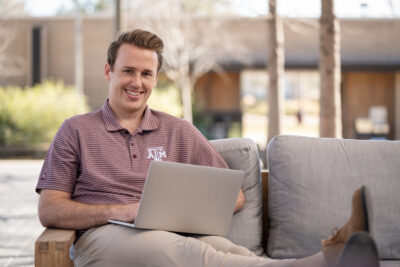A Brave New Online World at Mays
April 11, 2024
|
By Jeannie Ralston

Mays’ new Flex Online masters’ programs are tapping into the combined power of technology and Aggie core values to produce graduate-level programs like no other.
Daniel Sirias ’24 may seem like a typical Aggie, full of Good Bull. He proposed to his long-time girlfriend, Rebecca, under the Century Tree on campus. He chose to do so Sept. 12, 2023, in honor of the 12th Man. Aggie friends helped him set up the scene, scattering rose petals on the pathway and placing flowers and champagne on the bench but he is not a typical Aggie. He’s what could be considered an Aggie of the future.
Sirias is among the first students enrolled in a ground-breaking program at Mays Business School called Flex Online. He’s earning his graduate degree in management information systems while he works at the Pentagon in the nation’s capital, but he is soaking up the full Texas A&M University experience nonetheless due to the careful design of the new program.
“We were in College Station for a football game and a Mays event,” said Sirias, who had planned to attend Texas A&M as an undergraduate until life circumstances got in the way. Now, thanks to the online program, he can attend Texas A&M remotely. Two classmates he got to know through Flex Online were on-hand to videotape and celebrate with them. “I’m here in Washington, DC, trying to plan an engagement in Texas. I couldn’t have done it without their help. It goes back to Aggies helping Aggies.”
Jumping Ahead
During COVID-19, schools everywhere, including higher education, were thrown into online classes, and that experience has tarnished the perception, to some degree, of how online classes are conducted and what can be achieved. But for faculty at Mays Business School, the pandemic offered a silver lining — a large experiment that demonstrated what doesn’t work and the potential for delivering classes online. Two graduate programs at Mays were launched independently because of experiences learned during COVID. In early 2023, Dean Nate Sharp designated online graduate programs as a top priority for Mays by announcing plans to launch an online MBA program by Fall 2024. The online MBA program announcement was followed by shared plans to launch multiple online specialty master’s programs with the online MBA as a suite of programs named Flex Online. The suite of Flex Online programs will include reconceptualized versions of the management information systems and accounting programs to align them under the Flex Online portfolio.
There are more than 300 online MBA programs in the U.S., which puts Mays a little late to the game. However, `Jon (Sean) Jasperson, associate dean for academic innovation and the director of Flex Online, saw an advantage: The successes and shortcomings of other programs can be studied to build a more robust way to unleash the power of technology and humanity. And the first problem Mays was determined not to repeat is having the online program development and delivery outsourced. The Mays Flex Online programs would be developed in-house by faculty and staff who know the importance of maintaining Texas A&M Core Values and character.
Jasperson and his team started with a blank slate and a mandate to re-imagine education that is geared to working adults studying remotely. What they’ve come up with is revolutionary in the way courses are conceptualized and delivered and the way students are engaged and brought into the Aggie community.

“We are going about everything with great intention. We don’t want to be perceived as a university that just throws a bunch of courses on the internet,” said Jasperson, who explained that Flex Online is specifically targeting professionals who are now used to doing business via Zoom and other online tools and seeking ways to further their education while keeping their jobs. “We started by looking holistically at what is the right education to give a business student today. We’re assembling world-class learning design, learning media, and learning delivery experts to build a comprehensive support team. Then, we’re working with world-class faculty to build preeminent online education experiences. While Mays faculty members may have taught their course many times over many years, we want them to think about their course from a different perspective that allows them to consider the type of student learners we’re targeting. Then, we challenge faculty members to intentionally design the learning experience to meet the needs of the students we’re targeting in our programs.”
The move online was inevitable, according to Kayla Cline, a clinical assistant professor who teaches both in-person and Flex Online classes. She is also the program director for Flex Online MS Accounting. “Historically, online courses were perceived as not as valuable as a face-to-face course, but we’re proving them wrong. What we’re trying to do is differentiate ourselves in terms of how we do it, to convey some of that Aggie Spirit digitally.”
Indeed, Michaela Beck ’17, who is earning her MS Accounting degree online, reported that if not for the online option, it would be difficult for her to pursue her degree while working full time and raising two young children, especially with her husband attending the police academy. “This program has been a blessing, from the professors to the classmates I’ve met to the ability to balance everything,” said Beck. Living in New Waverly, Texas, Beck wanted to earn her master’s earlier in her career but had to delay her graduate education to complete her military service. “The course load is very manageable, very doable.”
Jasperson and his 15-person (and growing) staff on the Mays Teaching & Learning Innovation Team will build more than 100 online courses over the next two years for online master’s degrees in accounting, business administration, entrepreneurial leadership, human resource management, marketing, and management information systems. Collectively, these programs are referred to as the Flex Online master’s programs. Online offerings for the specialized graduate degrees in other areas like analytics, finance, real estate, and supply chain management are on the drawing board. Jasperson predicts 3,000 to 4,000 graduate students will be enrolled across the Flex Online programs in the next few years.
“We’re not just launching an online MBA program, we’re launching a full portfolio of online course offerings called Flex Online,” said Jasperson. “I’m not aware of any business school that is systematically trying to deliver multiple programs with a common look and theme and are focused on using technology to engage students in a new way.”
Developing a Course
When Jasperson started building the Flex Online program, the instructional designers (those who study how people learn and how to reach them) told him that it takes 30-35 weeks to build a new course. Knowing they were on the clock for a fall 2024 initial launch, he challenged them to reduce that time to 16 weeks. They did so by building an eight-week online course for the professors who will be teaching their class online. This pre-work course provides faculty members an example of what their online courses will be and helps them prepare for the intensive 16-week course development process. “In the online course, the faculty members have readings, reflection papers, and homework assignments. They are expected to complete this work while simultaneously balancing the other demands on their time such as their full-time job as a faculty member, family/social commitments, and life in general. We wanted faculty to experience what their students will experience while completing a Flex Online degree,” said Jasperson.
“By the time you jump into course development, if you’ve already done that eight-week course, you’ve already got the juices flowing,” said Cline. Following the introductory course, each professor is ready to work for 16 weeks with the Mays Teaching & Learning Innovation Team to develop their own Flex Online course.
“We do not tell faculty members to go figure out how to put their course online by themselves. Instead, we tell faculty members we have a team of learning design experts who have experience in curriculum development, adult learning theory, and online teaching who will help you re-envision your course for online delivery.” said Jen Ferrara, director of learning design, “we are going to partner with you every step of the way and provide the support you need.”
Part of Ferrara’s job is to free professors from conventions. “Traditional higher education teaching is to use a textbook and then assess learning through quizzes, or a midterm and a final exam, and perhaps a paper or a project,” said Ferrara. “The online adult learner demands more from their learning experience – networking opportunities, engagement with peers, and real-world application of learning. While faculty members are experts in their content area, the Teaching & Learning Innovation team members are experts in how to deliver engaging, meaningful content in the online space.”
Ferrara and her team focus on the learning objectives for each class and help the professor work in reverse, an approach called “backward design,” to identify ways to achieve those objectives, including determining the sequence of topics covered throughout the course and developing opportunities to apply real-world skills. “Maybe a professor has a favorite assignment used every semester,” said Jasperson. “We help the faculty member realize that the success of the assignment is in part dependent upon people being face-to-face in the same room. So, we’ll work with the faculty member to reconceptualize the assignment for use online and still make it a really good assignment. We’re always thinking about the students’ experience.”
Many professors who have been through the training say that it has elevated their approach to teaching in general. “It stands to reason that content of high production value, that is well-planned, edited, and developed by an entire team will surpass any course lacking these,” commented John Brady, an associate program director and lecturer of career management. “What I’m appreciating about the course development process as a whole is that there are several places where we are forced to think more actively about what gets baked in, and of equal importance, what doesn’t.”
Delivering the Goods
The Flex Online courses transcend what students have experienced before in many ways. The courses are set up as both asynchronous (learning at your own speed, on your own) and synchronous (engaging in real-time with a professor and a class). Each class is eight-weeks long (versus the typical semester covering 15-16 weeks), with each course divided into weekly modules. Students cannot rush through a course at their own pace; the design is meant to ensure engagement and support one module, one week at a time.
Within each weekly module students are presented with a set of intentionally selected learning resources such as articles, interactive media, podcasts, discussion boards, etc. These resources will include videos pre-recorded by the faculty member with support from the learning media staff on Jasperson’s team. Research on student engagement suggests that pre-recorded videos should be divided into segments. “It’s very short clips — we call it chunked media — because research shows that adult learners engage with recorded media for about six minutes before they begin to disengage,” reported Ferrara, who noted that there is an entire learning media team to create and edit instructional videos for the faculty members.
Based on research, current industry best practice is to encourage faculty to move away from the talking-head, “sage on the stage” model in online classes. “The videos are planned intentionally so they are engaging and at times the professor might record a demo of how to use a tool or apply an analytical technique to solve a problem,” said Ferrara. There’s room for professors to get creative in a social media kind of way — possibly shooting some video on their own phone when they encounter a real-world example of a concept taught in class. A key differentiator is that instructional videos will be carefully planned with the support of the learning media team.

Flex Online courses will be different from other online courses by including synchronous class sessions for the students. Each week, students meet with their professor and the other students in the course for a 90-minute live Zoom class. The professor leads the session from a state-of-the-art virtual learning studio on campus. Students keep their cameras on, allowing everyone to see each other, and during the class, the professor often divides the class into smaller groups via breakout rooms so they can discuss the material or work on an assignment together. “The teaching assistant or I can jump into [the breakout] rooms to see if there are any questions or if the students need any help. So, it’s a chance for them to get to talk to their peers, talk to their professors, and ask questions,” said Cline. While students attend her online office hours, Cline has found that many students want to “hang out” on Zoom after the 90-minute class ends to ask questions and strengthen their connections to the Aggie Network by socializing with her and their class peers.
During the Zoom class sessions, technical experts are available as “producers” to make sure the session runs seamlessly and new technology is being used to deliver the best possible experience. For instance, professors can use an “e-glass,” which allows them to write on a clear, “window-like” glass board without turning their back to the students. Software connected to the glass board flips the writing from the professor’s side of the board to display correctly (read left to right) on the students’ side of the board while it is streamed to the Zoom session. Another advanced technology in the virtual learning studio is an AI-enabled camera that will record what a professor is writing on a whiteboard but will mask out the professor while the content written on the whiteboard is streamed to the Zoom participants.
During the course, students are asked to discuss topics on a message board, in which they ask questions and address topics introduced by other students. “They learn from one another and supplement what they’re learning from the faculty member,” said Jasperson. “There’s lots of research evidence that says students learn more or better from each other than from a professor.” This is particularly advantageous for working professionals since they can benefit from the experience of their peers, who may be farther along in their careers and can provide important perspective. (Another way students engage is through social media groups or chat technology they set up themselves and meet-ups arranged by Mays for those sharing common interests — such as for veterans, mothers, or entrepreneurs.)
Daniel Sirias ’24 has a practical perspective on the value of the Flex Online courses because he can compare them to classes he took to earn his undergraduate degree which he earned online. “In my undergraduate program, professors were limited with time and scheduling, mostly stemming from a larger enrollment of students and restricted video conferencing. Flexibility was great, but there was minimal virtual communication, which sometimes hindered our ability to connect directly with the professor and other students,” he said. “Mays is definitely more dynamic. It is a really tight cohort, which makes it nice because you learn about everyone’s background, experience, story, and so forth. In my other program, you had hundreds of people online, and you never made those connections.”
Creating Aggies
A central question on the minds of those developing Flex Online is how to nurture the Aggie-ness that students on campus pick up naturally. One answer is to host at least one in-person activity or event on the College Station campus for each cohort in a degree program. “A lot of that time will be spent on team building and networking,” said Myra Gonzalez, the director of the Flex Online MBA program. “But of course, we’ll also go over the nuts and bolts of the program before we get started — student handbook type material.” In addition, time will be made for an immersion into the traditions and culture of Texas A&M. “We have always felt strongly that you can’t really be an Aggie if you don’t understand all of the lingo,” Gonzalez said.
When the in-person, on-campus orientation was offered for the online programs that started fall 2023, some anticipated that many students might decline, saying that they were taking classes online so they wouldn’t need to travel to or live in College Station. “But many showed up and loved it and raved about it because it was an opportunity to be part of the campus community, be part of the Aggie Network,” Ferrara said.
Gonzalez ensures that announcements and communications have a distinct Aggie flair. “We might say something like, `Beat the hell outta midterms.’ And we’ll sometimes sprinkle in extracurricular stuff like Aggie football scores or predictions,” she said.
The staff knows that earning an Aggie Ring and tapping into the Aggie Network is a big part of the appeal of a Texas A&M education. Indeed, Sirias has already connected with the Former Student chapter in the Washington DC area, which is some 500 people strong. “It’s important,” said Gonzalez, “that they’re comfortable jumping right into a conversation with any other Aggie.” Or staking out space to propose under the Century Tree.


